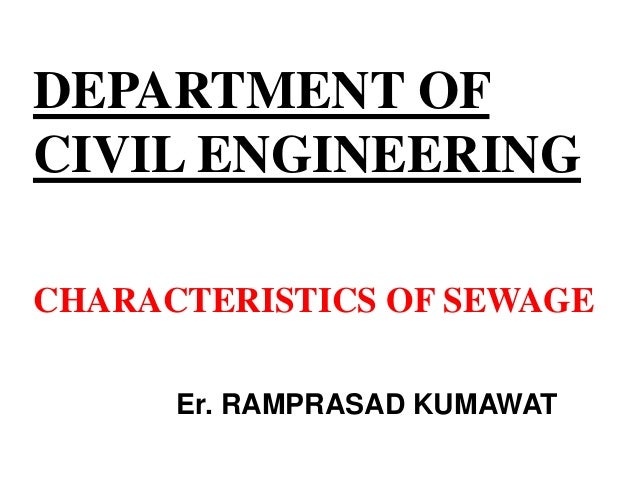
characteristicsofsewage-180110175620.pdf
- 1. DEPARTMENT OF CIVIL ENGINEERING CHARACTERISTICS OF SEWAGE Er. RAMPRASAD KUMAWAT
- 2. INTRODUCTION • Sewage consists of various residential, public and industrial mixtures of wastewater, which contain organic and inorganic materials in dissolved or suspended or colloidal form as well as various microorganisms useful and harmful to human life. • We need the characteristics and examination of sewage before designing any sewage treatment system to work efficiently.
- 3. Characteristics OF SEWAGE / Waste water • The Characteristics of sewage arc classified as follows: 1. Physical characteristics 2. Chemical characteristics and 3. Biological characteristics
- 5. A . Color : Color is due to the suspended and other matters found in wastewater. If sewage is fresh it has a soap solution color i.e grey-brown and decomposed sewage has dark grey color. B. Odour: Fresh sewage is of soapy or oily odour but stale sewage has offensive odour due to H2S, CH4
- 6. • C. Temperature: Generally sewage has slightly higher temperature than the water which increases the biological activities. 40 degree C. D . Turbidity : It is very turbid than water due to the presence of high suspended and other
- 7. E. Solids : 350-1200 mg/L • Though sewerage typically contains lower than zero to 0.5 % solids, the remainder being water, still the nuisance caused by the solids cannot be unnoted, as these solids are extremely degradable and so want correct disposal. • The sewerage solids could also be classified into dissolved solids, suspended solids and volatile suspended solids.
- 8. • Data of the volatile or organic fraction of solid, that decomposes, becomes necessary, as this constitutes the load on biological treatment units or resources of a stream once sewerage is disposed off by dilution. • The estimation of suspended solids, each organic and inorganic, provides a general image of the load on deposit and grit removal system throughout sewerage treatment. Dissolved inorganic fraction is to be thought-about once sewerage is employed for land irrigation or the other utilize is planned.
- 9. 2. Chemical Characteristics • Sewage contains complex compounds derived from urine, faces, inorganic chemicals etc. • a. pH • b. DO (Dissolved Oxygen) • c. BOD (Biochemical Oxygen Demand) • d. COD (Chemical Oxygen Demand)
- 10. • a. pH • The hydrogen ion concentration expressed as pH scale, could be a valuable parameter within the operation of biological units. • The pH scale of the contemporary sewerage is slightly quite the water provided to the community. However, decomposition of organic matter might lower the pH scale, whereas the presence of business waste material might manufacture extreme fluctuations typically the pH scale of raw sewerage is within the vary 5 to 8.0.
- 11. • DO (Dissolved Oxygen): It is the amount of oxygen dissolved in waste water. Presence it indicates the sewage is fresh or oxidation has been occurred after treatment. It is necessary to ensure at least 4 ppm of DO in stream in which treated wastewater is disposed otherwise fish are likely to be killed. • BOD (Biochemical Oxygen Demand) BOD is defined as the amount of oxygen required for the bacteria to oxidize the organic matter present in the sewage. BOD – 80 mg/L
- 12. • COD (Chemical Oxygen Demand) • It is defined as the amount of oxygen required for chemical oxidation of organic matters readily oxidizable carbonaceous and other matter. • COD – 150 mg/L
- 14. 3. Biological characteristics • Domestic sewage consists of various types of plant or animal microorganism and the biological characteristic of sewage is related to the presence of these microorganisms. • This microorganism whose presence is 22 — 25 millions numbers in a liter of sewage may be pathogenic, indicator organisms etc. The main source of pathogenic microorganism is excreta from sick people and these organisms require living tissues to grow and reproduce and harmful to man.
- 15. The microorganism can be broadly classified into: • (a) Aquatic plants • (b) Aquatic animals • (c) Aquatic mold (fungi), bacteria and virus.
- 16. • Aquatic Plants consists of waterweeds algae etc. • Aquatic animals consist of fish, snails, amphibians insects, earth Worms, hydra etc. • Aquatic mold (fungi), bacteria and virus are also aquatic plant but categorized separately. These are responsible for disease.
- 17. • The bacterium which needs free oxygen to survive is called aerobic bacteria and which survives without free oxygen is called anaerobic bacteria and which survives in presence or absence of free oxygen is called facultative bacteria. • The decomposition of sewage is possible due to these bacteria.
- 18. • Email ID : • ramkumawat001@gmail.com THANKS!